Storage tank for water in the house. How to make a backup water supply system
The water supply for a private home is most often made from a well and a borehole. For automatic feeding pumps are used. Their type and performance are selected depending on the water consumption and the height to which it needs to be raised. There are two types of private water supply systems:
- with storage tank;
- with hydraulic accumulator.
For uninterrupted water supply to a private home with stable pressure and water supply, you can install both a storage tank and a hydraulic accumulator. This is an option for those who value comfort.
System with storage tank
The basis of such a system is a water tank, which is installed at a considerable height. If there is space, the tank is placed in the attic; if not, you can build a special tower or install it on the roof of a neighboring building. Pipes radiate from the tank throughout the house, distributing water to points of consumption.
Water supply system for a private house with a storage tank (from a well or well - it doesn’t matter)
This system works like this:
- Water from a well or borehole is pumped into the container, its level is controlled by a float mechanism. When the threshold value is reached, the pump is switched off.
- Due to the fact that the storage tank is located above all water distribution points, some pressure is created in the system. When the tap is opened, this pressure causes water to flow to the distribution point.
- When the water level in the tank drops below a certain level, the pump turns on, adding water.
Water supply system for a private house or cottage with storage tank simple and inexpensive. But there are a number of serious disadvantages:
- With such an organization of water supply, the pressure in the system is low, and even variable - it depends on the water level in the container and the number of open taps. Because of this, no Appliances will not work (automatic washing machine, electric water heater(boiler), dishwasher, autonomous heating system, etc.).
- If the automation fails, there is a real threat of flooding the house with water overflowing. The danger can be reduced by installing an emergency water drainage system. To do this, a pipe is welded into the storage tank just above the required water level, through which the excess flows out if the level rises. The pipe can be taken to the sewer or drainage system, or maybe go to the garden. But some kind of indication is needed that there is too much water in the tank (the sound of pouring water is also one of the signals).
- The container is quite large, and finding a place for it is not always easy. An alternative is to build a tower next to the house on which to place a water tank.
If no equipment is expected at the dacha, you can use this water supply scheme. But few people in the house will be happy with this option. You will need to consider the following option.
Scheme with hydraulic accumulator and pumping station
This water supply system for a private house from a well and a borehole provides stable pressure, so you can connect any equipment. It is also based on a pump, but it supplies water to the hydraulic accumulator and is controlled by an automation system. If all these components are combined into one device, it is called a pumping station.

A hydraulic accumulator for water supply is an iron tank divided by an elastic membrane (rubber) into two parts. In one part, gas is pumped under a certain pressure, and water flows into the second. Filling the tank with water, it stretches the membrane, compressing the gas even more, which is why pressure is created in the system.
The operating principle of a water supply system with a hydraulic accumulator is as follows:
- The pump turns on, pumps water, creating the specified pressure in the system. It is controlled by sensors. There are two of them: upper and lower pressure thresholds. When the upper threshold is reached, the sensor turns off the pump.
- When a tap is opened or water is consumed by equipment, the pressure in the system gradually decreases. When the lower threshold is reached, the second sensor gives a command to turn on the pump. Water is supplied again, leveling it.
Such a system autonomous water supply gives more high level comfort. But its organization requires more funds: a pumping station and a hydraulic accumulator are enough expensive devices. In addition, this equipment is more demanding on water quality (minimum impurities), for which a good filter must be installed. There are requirements for both the pipeline (smooth internal walls) and the performance of the pump: water must be supplied constantly, without interruption. When using a well as a source of water, it must have a good flow rate (water must flow quickly), which is not always possible. Therefore, such schemes are more often implemented with wells.
Watch the video on how to assemble a well pump.
Water supply to a private house from a well and a well: pipe laying
Any of the described water supply schemes for a private house is implemented using a pump that supplies water to the house. In this case, a pipeline must be constructed connecting the well or borehole with a pumping station or storage tank. There are two options for laying pipes - only for summer use or for all-season (winter) use.
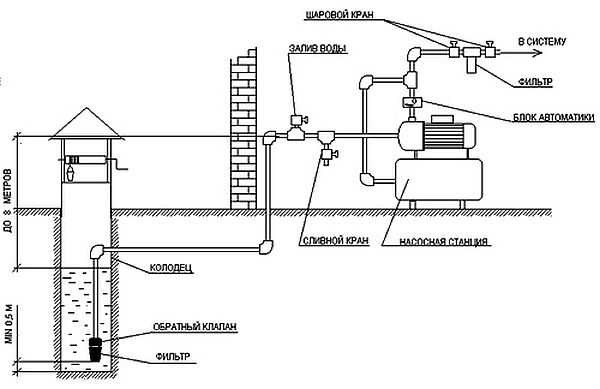
When installing summer water supply(for summer cottages) pipes can be laid on top or in shallow ditches. At the same time, you need to remember to make a tap at the lowest point - drain the water before winter, so that frozen water does not break the system in cold weather. Or make the system collapsible - from pipes that can be rolled onto threaded fittings- and these are HDPE pipes. Then in the fall everything can be disassembled, twisted and stored. Return everything in the spring.
Laying water supply pipes around the site for winter use requires a lot of time, effort and money. Even in the most severe frosts they should not freeze. And there are two solutions:
- lay them below the freezing depth of the soil;
- bury it shallowly, but be sure to heat it or insulate it (or you can do both).
Deep placement
It makes sense to bury water pipes deeply if it freezes no more than 1.8 m. You will have to dig another 20 cm deeper, and then pour sand into the bottom, in which to lay the pipes in a protective shell: they will be subject to a significant load, because on top almost two-meter layer of soil. Previously, asbestos pipes were used as a protective shell. Today there is also a plastic corrugated sleeve. It is cheaper and lighter, it is easier to lay pipes in it and give it the desired shape.
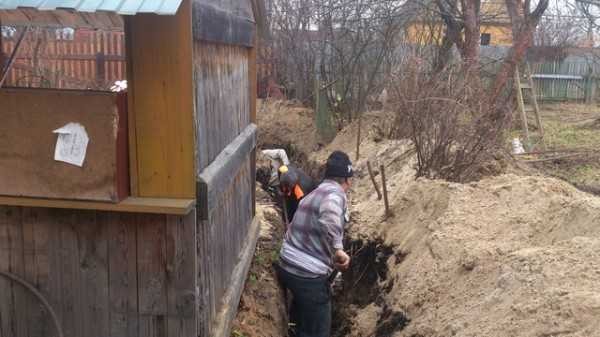
When laying a pipeline below the freezing depth, you have to dig a deep trench along the entire route. But the water supply to a private house from a well and a borehole will not freeze in winter
Although this method requires a lot of labor, it is used because it is reliable. In any case, they try to lay the section of the water supply between the well or borehole and the house exactly below the freezing depth. The pipe is brought out through the wall of the well below the freezing depth of the soil and is led into a trench under the house, where it is raised higher. The most problem area- exit from the ground into the house, can be additionally heated with an electric heating cable. It works automatically supporting set temperature heating - works only if the temperature is below the set one.
When using a well and a pumping station as a water source, a caisson is installed. It is buried below the freezing depth of the soil, and equipment is installed in it - a pumping station. The casing pipe is cut so that it is above the bottom of the caisson, and the pipeline is led out through the wall of the caisson, also below the freezing depth.
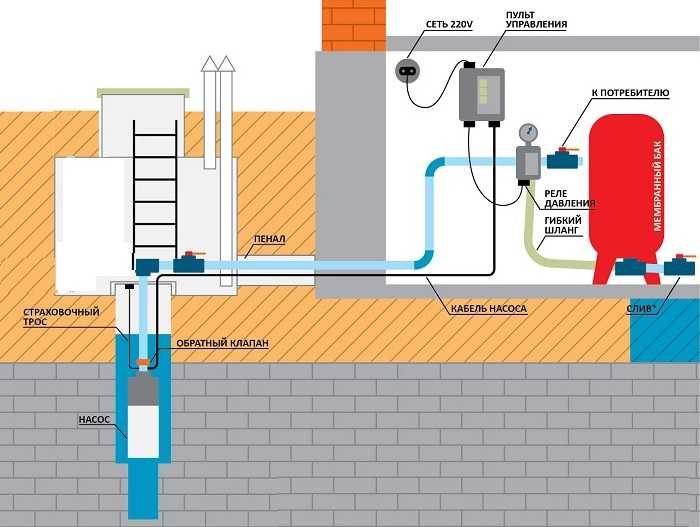
A water pipeline buried in the ground is difficult to repair: you will have to dig it up. Therefore, try to lay a solid pipe without joints or welds: these are the ones that cause the most problems.
Close to the surface
For shallow placement earthworks less, but in this case it makes sense to make a full-fledged route: line the trench with bricks, thin concrete slabs and so on. At the construction stage, the costs are significant, but operation is convenient, repairs and modernization are without problems.
In this case, the water supply pipes for a private house from the well and borehole are raised to the level of the trench and discharged there. They are placed in thermal insulation to prevent them from freezing. To be on the safe side, you can also heat them - use heating cables.
One practical advice: if a power supply cable runs from a submersible or borehole pump to the house, it can be hidden in a protective sheath made of PVC or other material, and then attached to the pipe. Secure every meter with a piece of tape. This way you will be sure that electrical part you are safe, the cable will not fray or break: when the ground moves, the load will be on the pipe, not on the cable.
Sealing the entrance to the well
When organizing water supply for a private house from a well with your own hands, pay attention to sealing the outlet water pipe from the mine. It is from here that dirty water most often gets inside.

If the hole in the shaft wall is not much larger diameter pipes, the gap can be sealed with sealant. If the gap is large, it is covered with a solution, and after drying it is coated with waterproofing composition(bitumen impregnation, for example, or a cement-based composition). It is advisable to lubricate both the outside and the inside.
What does it consist of?
The source of water and its introduction into the house is not the entire water supply system. More filters are needed. The first, coarse filtration occurs at the suction point. In this form, it can be used for technical purposes, for example, to put it in the toilet. But even for irrigation, untreated water cannot be supplied in every case, and even more so in the shower or in the kitchen. Therefore, the water supply to a private house from a well and a borehole also includes a filter system.

Water supply plan for a private house from a well
Please note: in the figure there are three stages of filtration:
- on the suction pipe - strainer;
- before entering the pump there is a coarse filter;
- before serving into the house - a fine filter.
At each stage, the filter (or filters) is selected depending on the water. Its quality is determined in the laboratory. Based chemical composition and cleaning equipment is selected.
Autonomous water supply
Systems with pumping stations are good for everyone, except for the fact that they require electricity to operate. There is a water supply, but it is equal to the volume of the hydraulic accumulator, and it is no more than 100 liters. This amount will not last long. If you need a reserve supply for at least a day or more, it is best to pump water first into a storage tank, and from it supply it to the inlet of the pumping station. The same system works well if your house is connected to a centralized water supply, but the pressure is very low or water is supplied hourly.
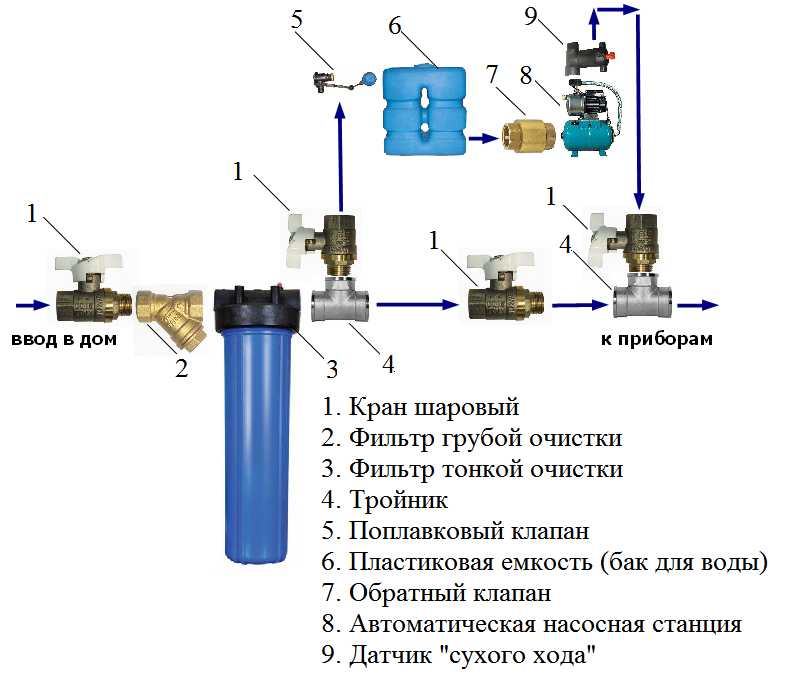
In the diagram presented in the photo there is no only emergency overflow. This is the pipeline coming out of storage tank slightly above the maximum water level. It is discharged into the sewer. Excess water flows through it in case of problems with the float mechanism. If you don't install it, you could flood your house.
If you need backup water supply to a private home in case of a power outage, the storage tank should be installed at the top, above all water points. Then, when the electricity is turned off, water will flow into the pipes by gravity. You won't be able to take a shower, but there will be water in the taps. This will provide uninterrupted water supply to a private home in any conditions.
The comfort of everyone who lives in it depends on how well the water supply scheme of a private house is designed and reliably installed. In many cases, the owner has a choice between several alternative options. In order not to blindly choose one of them, it is important to carefully study all the features, advantages and disadvantages.
The choice of the type of water supply at home or, more simply, determining where the water will actually come from to the house depends on individual conditions.
Central water supply at home
The technical design of such a system is simpler than all other options. In fact, it is necessary to install a tie-in into the common pipeline and a diagram of the water supply distribution in the house, drawn up in compliance with the dimensions and indicating all points of water consumption. In accordance with it, the pipeline is installed indoors. From a common pipeline you can bring hot and cold or only cold water. In the second case, the diagram should provide water heating equipment.
All of the above options are possible only in one case - if there is a water main in relative proximity to the house.
Despite the ease, the water supply scheme from central water supply It also has its disadvantages:
- periodically observed decrease in pressure up to complete cessation of water supply during peak consumption hours,
- dependence on the operation of utility equipment (water is turned off due to accidents or during pressure testing),
- the need for monthly payment and control of fluid consumption.
The advantages of this option, in addition to ease of installation, include the low cost of project implementation (minimum necessary equipment), as well as independence of water supply from electricity supply. Well, its disadvantages include the need to get an insert into main pipe appropriate permission.
Autonomous water supply at home
An autonomous water supply scheme in a house involves the use of a separate source located on or near the site. Such a source can be:
- well,
- well for sand (including the so-called Abyssinian well or needle hole),
- an artesian well that extracts fluid from a calcareous aquifer.
Each of these options, with its advantages and disadvantages, deserves special attention.
Wells
In order for there to be water in the well High Quality, important meet certain requirements:
- find the optimal location for digging a well (high liquid content in the aquifer, distance from the house to eliminate the possibility of destruction, absence of possible sources of pollution, including landfills, within a radius of 50 meters, cesspools, septic tanks, etc.),
- install reliable and protective water drains, large quantity sand and clay walls,
- Protect the mirror from dust and debris by installing a tight-fitting cover.
 The well will not leave you without water even during power outages
The well will not leave you without water even during power outages At the same time, even if these requirements are met, before using water at home for cooking and drinking, it is better to do a laboratory analysis. Its results will not only guarantee the compliance of water quality sanitary requirements and standards, but will also help you choose the right elements of the cleaning system.
The quality of water in a well, other things being equal, is usually lower than in a well. In addition, the well does not always have the required productivity. In order to avoid water shortages, it is recommended to ensure that there are three keys at the bottom when digging.
The advantage of wells is the combination of automatic water supply and the ability to get liquid manually in the absence of electricity using a bucket. Even with a long interruption in power supply, the house will not be left completely without water.
Wells on sand

A sand well has a shallow depth compared to an artesian well. Thanks to this feature, it is easy to do on the site yourself. This feature is a significant advantage because it allows you to save money on the project.
The disadvantages of a sand well are:
- fragility (service life is usually a little more than 6-7 years),
- possibility of siltation,
- not very high performance.
Artesian wells
Drilling of such wells is carried out to a depth of 50-150 meters or even more, therefore it must be carried out by professionals using special equipment and having previously obtained a work permit. Attracting specialists will require an investment, but such a source will last up to half a century or more, so all expenses can be considered a long-term investment.
An artesian well is highly productive. The limestone layer from which it lifts water is located deep, so toxic substances from the surface do not penetrate into it. Features include usually increased hardness of water from an artesian well, but this drawback is easily corrected by including a softener filter in the circuit.
Equipment for autonomous water supply systems for private houses
Pumps
Any autonomous water supply scheme includes pumping equipment.
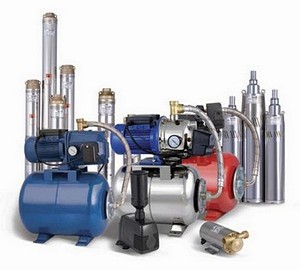 Equipment for water supply of private houses - pumping stations and deep submersible pumps
Equipment for water supply of private houses - pumping stations and deep submersible pumps - For a well, depending on its depth, both submersible and surface pumps can be used. When choosing, you should remember the need to protect surface equipment from freezing if you plan to use an autonomous water supply country house in the cold season.
- due to small diameter casing pipe can only be equipped with surface pumps.
- The depth of artesian wells requires the use of only submersible pumping equipment.
- are a set of equipment (pumping unit, hydraulic accumulator, pressure gauge, pressure switch and dry-running relay), however, they can only be used for shallow sources.
Devices for adjusting the operation of water supply systems
To obtain a supply of water in the house in case of an emergency and to adjust the operation of the system (preventing frequent activation of the pump, ensuring optimal pressure), a house water supply diagram can be used with storage tank or with hydraulic accumulator.

- Storage tank works on the principle of a pressure tower and is a container (for a house with permanent residence a volume of about 200 liters is suitable) with the appropriate equipment:
— incoming pipeline,
- water supply pipeline to the house,
- layer of insulation,
— heating heating elements,
— drain pipeline in case of emergency overflow of the container,
— float level controller.
The water supply scheme for a house with a storage tank involves installing the tank above all points of water consumption, for example, in the attic or other elevation.
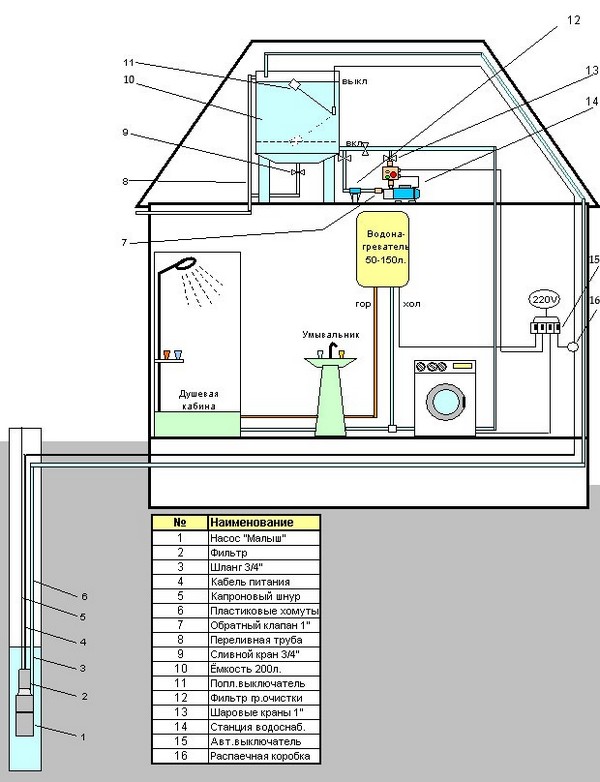
- – a more advanced device that allows you to set the optimal operating mode, including in accordance with the characteristics of the system and the required parameters (required water pressure). The water supply scheme for a private house with a hydraulic accumulator does not require raising the storage tank to a height; excess pressure is provided by compressed air. The hydraulic accumulator is installed in a separate heated room next to the well, in the basement of the house or in a caisson.
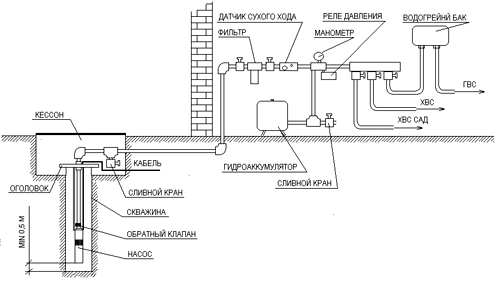 Water supply diagram for a house from a well with a hydraulic accumulator
Water supply diagram for a house from a well with a hydraulic accumulator If you are also planning installation heating system, then don't forget about .
Read about the ways in which this can be done in a separate article on the site.
It is a plastic “chamber” installed at the wellhead and protecting it and the installed pumping and storage equipment of the system from external influence, primarily from freezing. The caisson is a reliable alternative to a free-standing heated pump house.

Filter system
The water supply system of a private house with a storage tank or hydraulic accumulator necessarily includes a cleaning (filtering) complex. Even with excellent quality laboratory confirmed water, mechanical filters will be required to retain insoluble particles of sand or clay. Typically, coarse and fine filters are installed sequentially. Iron-reducing and installed depending on need.
Pipes
For the water supply system, pipes made of metal-plastic, cross-linked polyethylene, HDPE or polypropylene are selected in accordance with the characteristics of the scheme (surface or underground location, likelihood of temperature changes, etc.).
Important: When underground installation the pipes are located below the freezing level of the soil; in the case of surface pipes, they require mandatory insulation.
Installation, maintenance and repair of water supply systems
In order to ensure that repairs to the water supply system of a private home, either with your own hands or with the help of specialists, are required as rarely as possible, it is important to carry out installation and maintenance in full compliance with the requirements.
Installation of pipelines can be carried out by serial or collector connection water intake points. The first option is suitable only for a small number of them, otherwise in the last of the connected consumers the pressure will periodically decrease below the permissible value.
System maintenance work depends on the type of equipment installed. For example, large-volume hydraulic accumulators require periodic “bleeding” of air.
Regardless of the type of circuit, periodic inspections require connections between elements, wells require periodic cleaning, and artesian wells need to be pumped when water quality deteriorates or productivity decreases.
Video
Do-it-yourself installation of a water supply scheme for a country house with a hydraulic accumulator is shown in the video.
The reasons for the lack of water in the tap can be very different, and this situation can become critical for residents of city apartments. But a compact tank installed specifically for water solves the problem if the supply to the apartment has been temporarily interrupted.
Why do you need a storage tank in an apartment?
If there is no water in the tap, a storage tank can be a real salvation, and it can be installed in a private house or country house, as well as in a city apartment. The only difference in this case will be the size: for an apartment you should choose more compact and smaller containers, and not only because of the lack of space for their placement, but since the volume of consumption is much less. In this case, the tank with a supply of water is not autonomous, but is installed in the apartment’s water supply system in order to ensure automatic supply from it in the event of a shutdown in the main pipe. Less convenient option(but this is not critical) is to switch the container manually - by simply turning the tap.
It should be noted that owners of apartments in high-rise buildings experiencing problems with low pressure in the water supply may also think about installing water storage tanks in their apartments, the price of which is fully compensated by the comfort. In this case, the storage tank will work on the principle of replacement: selection is made from the reservoir, while the water supply in the apartment will have normal pressure indicators, and at the same time the freed volume is filled from the house water supply.

To solve the issue of backup water supply, containers can be used various types and type, but all of them can be divided into two groups:
⦁closed ones are membrane-type hydraulic accumulators, but when choosing this type of container, it should be taken into account that their useful volume is equal to a maximum of 2/3 of the volume, the rest is allocated to the air chamber.
When choosing a tank for storing water, you should give preference to products made from safe and environmentally friendly materials. pure materials, especially since the range of relevant products is quite wide. Water containers are made from:
⦁of stainless steel or treated with anti-corrosion materials, for example, varnishes, enamel or ceramic spraying;
⦁polypropylene;
⦁HDPE or LDPE (cross-linked low or high pressure polyethylene);
⦁PVC (polyvinyl chloride).
Depending on the type of material, the price and performance characteristics containers, which directly affect their service life.

How and where to install a water tank in an apartment
Before choosing a water tank, you should definitely determine the optimal volume of the container, taking into account the composition of the family and its needs. In a private house, this issue is resolved somewhat easier, since utility rooms can be used. For an apartment, the volume of the container can vary from approximately 100 to 300 liters.

Before purchasing, you should definitely decide where the water storage tank will be placed in the apartment and how it will be installed, especially taking into account the weight of the filled container. As a rule, so-called dead zones in the house are used for this; you can also consider installing a tank, for example, under the ceiling in the hallway, corridor, bathroom or even in the kitchen. In the event that a container of sufficiently large volume is installed, then it is best to choose floor options, but for an apartment you should still give preference to wall-mounted models. In this regard, it is important to pay attention to the shape of the product: for an apartment the best option the tanks will become cylindrical or flat.
The method of connecting the tank is also determined by its location:
⦁if the container is mounted using a hinged method, then water is drawn from it under the influence of gravity;
⦁for floor models the water supply is provided by a circular pump, which creates and maintains a certain pressure;
⦁for membrane-type containers, the installation location does not matter, due to the fact that the necessary pressure and pressure for supplying water to the water supply network is created due to the presence of an air chamber.
Even if the need to use reserve water reserves rarely arises, it is necessary to ensure periodic circulation, which will avoid stagnation; in addition, a tank cleaning procedure will sometimes be required, especially if the water quality is not ideal.
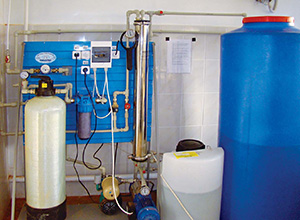
Buying a water storage tank for an apartment
The Alfatep company offers a wide range of products for home water supply, including water storage tanks. All issues related to calculating the volume of a container and choosing a method for its installation can be easily resolved by taking advantage of the consultation of our specialists, who will also help you choose required types fastenings and connections for installation work.
In order to get acquainted with the offered range of products, there is no need to even leave home: all categories and types of goods are presented in the Alfatep online store. You can make a purchase directly on the website; in addition, we recommend using the services of our transport service, which will promptly deliver the goods to the specified facility. And if you need help from a specialist installing equipment, our highly qualified specialists are always ready to help.
The storage tank eliminates the problem of lack of water due to interruptions in the central water supply or a power outage if a booster pump was used.
In this article, read about the types of storage tanks and how to choose the right one.
Using a storage tank
A storage tank is a reservoir with a supply of water that acts as a hydraulic accumulator. Its main task is to maintain uninterrupted water supply to the consumer when the central source stops operating.
In the apartment
Each owner of an apartment in multi-storey building faced a water supply shutdown or water supply on an hourly basis. Residents of the upper floors are also familiar with weak pressure due to low blood pressure. The solution to water problems can be a storage tank.
The idea of the design is that during a regular water supply, the reservoir is filled, and if the pressure drops or the water supply is turned off, water from the storage is sent to all water intake points in the apartment.
It is recommended to choose the tank size for an apartment in the range of 100-200 liters. This is enough to satisfy the primary needs of an average family of three for a period of several hours to a day. Typically a tank with a float is used, which allows you to maintain an optimal water level.
The volume of the tank is selected individually, based on the area of the apartment, family size, frequency of water interruptions, etc.
In the house
In private houses with centralized water supply A similar situation arises with water supply. Water consumption in a house is usually higher, because on the territory there is usually a garden, vegetable garden, flower beds, and sometimes also livestock. Thus, the volume of water reserves should be tens of times greater than in the apartment.
For such cases, manufacturers suggest purchasing tanks with a volume of 1500 to 5000 liters (sometimes up to 10,000, but such are rarely used on the farm). The size of the tank will be impressive, but there are usually no problems with placement - a container of water can be installed in the yard, garage, barn and other households. buildings. There is a practice of burying the tank in the ground - this saves usable space on the site.
In the case of a tank buried in the ground, there is another advantage: in winter it does not need to be heated, since the temperature deep in the soil will not drop below zero.
The underground storage tank must have a ribbed surface and be strong enough to withstand the force of soil pressure.
In the country
The dacha differs from the cases described above in that, in most cases, there is no connection to a centralized water supply. Water has to be extracted and stored independently; for this, wells, boreholes and precipitation collection systems are used.
Tank for watering plants
![]() Such a tank is good because the water in it will not be too cold for watering plants, like, for example, straight from a well.
Such a tank is good because the water in it will not be too cold for watering plants, like, for example, straight from a well.
You can use a container for watering plants in your dacha in the event of a power outage (when the pump for a well or borehole is not working).
The watering tank should not be placed in the open sun - if the water heats up excessively, algae and microorganisms will begin to multiply intensively in it.
Tank for shower cabin
Summer showers at dachas are very popular. It helps to freshen up during the day, and in the evening, when the water in the tank has warmed up well, you can take full water procedures.
For a shower, you should buy a tank with a volume of 200-300 liters, preferably flat in shape (for convenient installation on the roof of the shower stall).
It’s good if the tank is dark (or better yet, black) in color, this will contribute to more intense heating of the water during the day.

Flat shower tank
How to choose a storage tank
The tank should be selected based on the tasks it will solve in the apartment (on the site). Basic parameters for choosing a container:
- volume;
- material;
- form;
- surface;
- nature of fastening;
- color.
The volume will be individual for each type of need. A tank for an apartment or a private house without a garden can be selected within the range of 100-300 liters. Thus, it will not take up much space and its volume will be enough to meet the primary needs of residents.
The volume of the country tank can be selected up to 5000 liters or more, it all depends on the irrigation area and the free space for storing water supplies.
As for the material, you need to be guided by the purpose of the water. If it is to be used for drinking and cooking, the material of the tank must be safe for human health (for example, food-grade plastic). In the case of a summer cottage, plastic also has an advantage over metal, since aggressive components that may be in the water will not actively interact with the container.
The shape of the tank also depends on specific needs. For apartments will do a small cylindrical tank (for easy storage), for country shower– flat (for reliable mounting on the booth). A tank dug into the ground can have any shape.
The surface of the reservoir matters when storing water underground. A ribbed and rough tank will be less subject to soil pressure, which will avoid deformation and movement.
Tank mount too important aspect. The tank can not only stand on the floor (ground), but also be suspended (relevant for small apartments so as not to take up floor space).
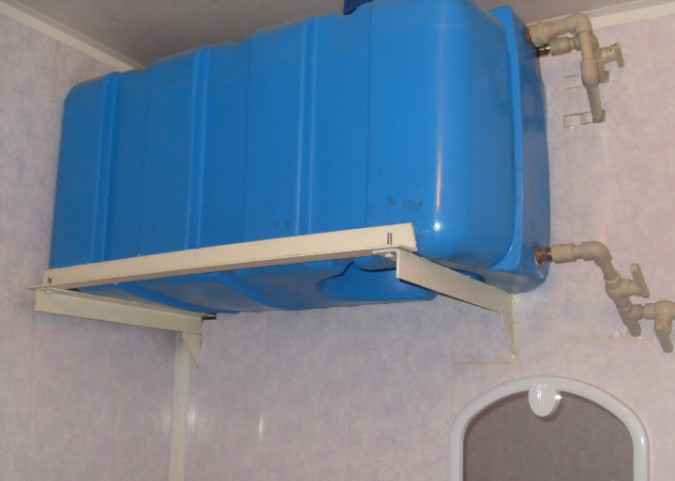
Color matters for heating (or vice versa, not heating) the water in the container. If you want the water to heat up under the influence of direct sun rays(shower) – choose dark color, if it is desirable for the water not to heat up above normal (irrigation tank), transparent, white or any light shade will do.
What else you need to know about storing water in a tank
- The water in the tank should not stagnate, otherwise it will spoil and be unfit for consumption. The water in the tank should be circulated as often as possible.
- When leaving the dacha for the winter, do not leave the container filled. The water will freeze and the pressure will most likely cause the tank to burst. If supplies were stored in the attic, water will flood the room when it thaws.
- The container requires periodic cleaning.
Before purchasing a storage tank, calculate how much water your family uses per day. The resulting figure will be the approximate volume of the tank that will suit you.
If the volume of water flow provided by the main water supply pipe is intermittent or insufficient, a storage tank for water supply will be required.
- Storage tank volume
- Automation and tank cleaning
Water supply schemes with storage tank
If, for example, the water supply system of a private house with a storage tank is such that the natural flow of water into a well or well is small, then it is necessary to provide a certain supply of water in case its consumption suddenly increases. During the day, water usually accumulates in such a tank, and in evening hour the peak is intensively consumed when each family member wants to wash. Sometimes water is supplied to a residential building at certain hours. In this case, a storage tank for water supply will help to collect required amount water so that you can use it at any time and without interruptions.
Storage tank volume
The volume of the storage tank directly depends on the number of people living:
- A volume of water per person of no more than 200 liters is considered sufficient for everyday household and household needs.
- For country water supply, which does not provide for some items of water consumption, for example, washing, to calculate the volume of the tank, one should proceed from the norm of no more than 80 liters per day per person, or even less. For a family of 2-3 people, a storage tank for water supply to a dacha with a capacity of 200 liters is quite suitable.
- If water is used only for food, drinking and washing dishes, as well as morning and evening washing, then even 30 liters per person may be enough.
What material to choose a storage tank from?
A storage tank for water supply made of plastic is a very common option today. For water, containers made of food-grade plastic or welded from stainless steel can be used. It is unprofitable to use ordinary steel for these purposes, since corrosion will quickly render the container unusable and will have to be replaced again. In addition, a tank made of the wrong material is more likely to leak or release unwanted substances into the stored water.
Methods for installing a storage tank
The storage tank can be installed underground, openly and inside the house. At open method The tank is installed on an elevated surface, thanks to which it will serve as a water tower and make the use of a pump unnecessary.
Only a small container is installed inside the house, which does not require much space.
You can hide an arbitrarily large tank underground, and place it above it, for example, garden beds. But for underground installation additional work will be required.
In addition, the container must have a certain configuration. Plastic tank should be round or ribbed, with technological holes for inspection and cleaning. If a “Eurocube” is used, then it will require a concrete shell, since a mesh fence will not save you from soil pressure.
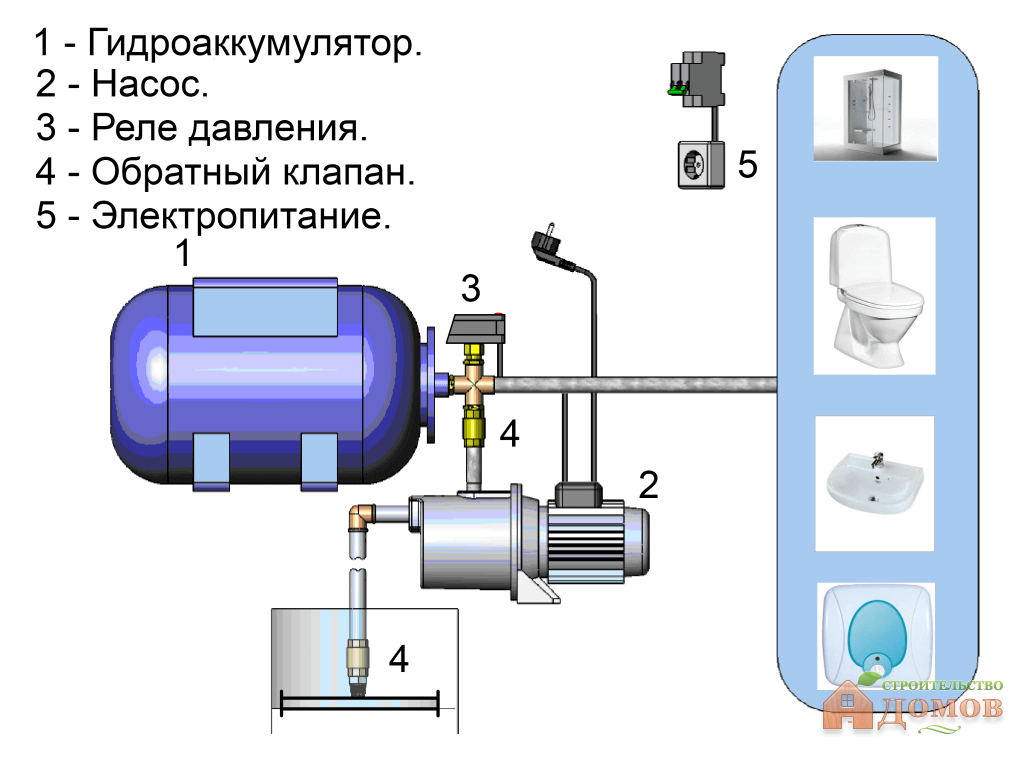
Automation and tank cleaning
These aspects must be taken into account when installing the tank. If water is supplied with normal pressure and a certain frequency, then the issue can be solved quite simply by installing a float valve for the toilet on the supply fitting. When filling the container, it will shut off the supply and the water will not overflow.
If water is taken from a shallow well or poorly filled well, then to supply it you need to use a drainage pump equipped with float switch. When the water level in the well drops to a critical level, the pump will automatically turn off.
If the water supply storage tank releases water through a pump, then a float or other switch will be required inside the tank itself. When the water level drops to a minimum, the pump will turn off. You can duplicate it with a water level, which is useful when using washing machine to make sure she has enough water to wash.
The nuances of installing a storage tank
To prevent the storage tank from becoming dirty longer, you need to install a water filter at its inlet. Usually it is mesh, but for large containers (more than a cubic meter) and with contaminated water, it is better to replace the quickly clogged mesh with a centrifugal filter pump or cyclone filter. Despite the high cost, a water supply with a storage tank and pump will be more economical to operate.
In the tank installed on the podium you need to do drainage hole, through which the sludge will drain during flushing.
When placed underground, the container is cleaned through the inspection hatch, from where dirt is removed from the bottom with a bucket. It is best to use a container with a flat bottom with a slight slope, in which the sludge will accumulate just under the inspection hatch, and it will be easier to remove it.
To prevent turbidity from rising from the bottom of the tank when water is supplied, the inlet pipe can be completed with a garden or shower head, or a mesh filter located inside the house can be installed on the outlet pipe for ease of maintenance and cleaning at any time.
Have you installed a storage tank as an addition to the water supply system? Or do you consider this an unnecessary detail? Share your opinion in the comments.
